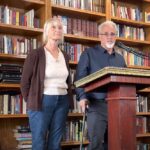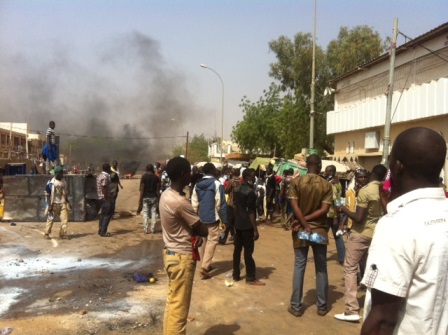
The publication of Charlie Hebdo’s ‘memorial edition’, with its depiction of the Prophet Muhammad crying, sparked – in one or two countries – a violent backlash against Westerners in general and Christians in particular. It was notable in Niger, where 70 churches were destroyed, Algeria where police and protestors clashed, and in Pakistan.
There, in Karachi, a march in the streets hit the international headlines. However, one incident which only emerged sometime after it happened took place in the Khyber Pakhtunkhwa province of north-west Pakistan. On January 26th, in the city of Bannu, the Pennell High School and College for 1,800 students was working as normal, despite the fact that a protest march against Charlie Hebdo had been called by other school and college students.
Pennell Principal Fredrick Farhan Das told World Watch Monitor that hundreds of protestors, mostly students between the ages of 15 and 18, broke away from their march to storm into the school after climbing up and forcing the main gate open.
“The protestors first pelted the gate with stones and then climbed over the 14-foot-high wall… Some of them were armed with knives and pistols; the young children were terrified that it was an attack like the one in the Army school in Peshawar where at least 132 students were massacred.”
Teacher Pervaiz Qazi added: “It was break time, around 11am. All the students were out of class, when those protesters entered …They created panic, started smashing windows, showing their weapons openly and raising anti-Christian slogans.”
Since the Peshawar attack, security around Pakistani schools has dramatically increased and schools have been ordered to take stringent security measures. Sources privy to the Punjab Education Department told World Watch Monitor that military schools and Christian mission schools across the country are designated as A+ category – at the highest security risk of being targeted.
Das explained: “There are two posts on the second floor where two policemen are permanently deployed by the district administration…When the protestors pelted the gate with stones I told the guards to keep the gate closed. If the two policemen had fired in the air, then the protestors would not have braved the boundary wall….They wanted the school closed…they damaged our property and smashed our windows. This caused a stampede. We had four students injured.”
USCIRF: Pakistan ‘poisoning textbooks with religious hatred’
For many years, Pakistani Christians have been subjected to violent attacks to avenge ‘anti-Islam acts’ taking place abroad, especially in Europe and the US.
The attacks stem from the perceptions that the West is Christian and the local Christian community is akin to them, that non-Muslims are “enemies of Islam,” and that jihad is a violent struggle against the “enemies of Islam,” mandated for every individual.
Such attacks began in early 1970s at least, as the timeline below shows, meaning the citizenship and patriotism of Pakistani Christians have long been under question.
The US Commission on International Religious Freedom (USCIRF) report “Connecting the Dots: Education and Religious Discrimination in Pakistan – A Study of Public Schools and Madrassas” notes: “the Pakistani national identity and Islamic religious identity are correlated. This is a similar emphasis on ‘Islamic Pakistan’ to that found in most textbooks.”
Though Pakistan was founded when its religion had “nothing to do with the business of the State”, the USCIRF report says that, through poisoning textbooks with religious hatred “Pakistani political leadership has undermined the tolerance once enjoyed amongst the various sects and religious minorities in Pakistan.”
The USCIRF research notes “In all the textbooks analysed, the student is presented a world where concepts such as nation, constitution, legality, standing armies, or multi-lateral organizations– except where they are prescribed by Islamic doctrine or sharia law–do not exist.”
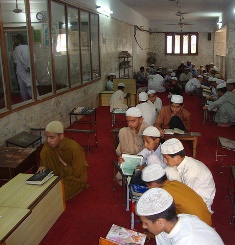
It went on to show that all public school teachers and students interviewed believed jihad meant violent struggle, compulsory for Muslims to engage in against the enemies of Islam, and about 80 percent of them viewed non-Muslims as “enemies of Islam.”
“The majority of public school teachers cited blasphemy against the Prophet Mohammed as a significant cause of anger towards religious minorities.”
The USCIRF report also says that that “foreign cultural invasion” through mass media is perceived a threat to Islam and the very existence to Pakistan. Similarly, the Christians living among them are perceived as perverted in their beliefs and immoral in their practices. Students and teachers said anger against religious minorities arises from “a feeling that they do not respect Islam and Muslims.”
Chart in USCIRF report, ‘Connecting the Dots’, showing % of teachers and students in favour of equal rights for Christians
| Madrassas [Islamic Religious Schools] | Public Schools teaching in Urdu | Public Schools teaching in English | |||
|---|---|---|---|---|---|
Teacher | Student | Teacher | Student | Teacher | Student |
| 18.5% | 18% | 52% | 66% | 81.5% | 84% |
The 2011 Pew Research Centre report titled “Rising Restrictions on Religion” characterizes Pakistan as the third least tolerant country to religious diversity, while another of its reports “Common Concerns About Islamic Extremism: Muslim-Western Tensions Persist” says that only 16 percent of Muslims in Pakistan hold a positive opinion of Christians.
Reverse timeline of incidents of anti-Christian violence triggered by external events, from 2015
Jan. 26, 2015: Protestors against ‘Charlie Hebdo’ stormed into Pennell High School and College in Bannu and scuffled with students and staff on. Protestors were aggrieved that Muslims were observing a strike while the Christian school remained open.
2013
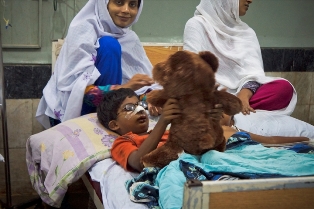
Sept. 22: Twin suicide bombers blew themselves up in All Saints’ Memorial Church in Peshawar. The attack instantly killed at least 81 worshippers as it took place when the Sunday service was ending. The final death a splinter group of the Taliban, named Junood ul-Hifsa, stated: “We carried out the suicide bombings at Peshawar church and will continue to strike foreigners and non-Muslims until drone attacks stop”.
2012
Sept. 21: Government of Pakistan announced a full day holiday to protest the anti-Islam film “Innocence of Muslims” and described this day as Yom-e-Ishq-e-Rasool (“Love of the Prophet” Day). Countrywide protests, which in some areas turned into riots, were held. One protest rally in Mardan stormed into the St. Paul’s Lutheran Church, set it on fire and looted “surrounding residential quarters”.
2006
Protest rallies were taken out across the country against the Danish newspaper Jyllands-Posten for publishing cartoons of the Prophet Muhammad. Edwardes College in Peshawar was ransacked by students. Two days later, St. Michael Convent School, St. Elizabeth Girls’ College and the Mission Hospital were ransacked. The same day protestors tried to enter the Presbyterian Christian Girls’ High School in Kasur but parents of Muslim girls stood in their way and saved the school from being attacked.
2002
Mar. 17: Five died and 41 injured in a hand grenade attack on the Protestant International Church in Islamabad.
Aug. 5: At least six were killed in a gun attack on Murree Christian School where most of the students were of foreign origin.
Aug. 9: A hand grenade attack on Taxila Mission Hospital chapel killed three nurses who were coming out after morning service.
Sept. 25: Seven workers of a Roman Catholic charity, Idara-e-Amn-o-Insaf (Committee for Peace and Justice) were tied up in their office and shot at point-blank range. The Christian Science Monitor described the attack as part of a “string of violent attacks against Christians … since Pakistani President Gen. Pervez Musharraf’s decision to crack down on Islamic extremist groups and join the US war against the Taliban and Al-Qaeda.” The National Catholic Reporter said that police reports stated that the attack was carried out by Lashkar-e-Jhangvi, a terrorist outfit.
Dec. 25: The United Presbyterian Church in Sialkot was attacked with hand grenades that killed three and injured another 15.
2001
At least six attacks on institutions and churches took place to revenge US-led so-called “war on terrorism” after 9/11.
Oct. 28: Three gunmen entered St. Dominic’s Church in Bahawalpur and killed at least 16 worshippers. A local Urdu newspaper reported that Lashkar-e-Omar (Army of Omar, a new terrorist group) took responsibility and stated: “We have accepted the crusade war by U.S. President George W. Bush. This is an answer to Bush.”
1992
Dec. 6: Extremist Hindus demolished Babri Mosque in India believing it was built by Mogul emperor Zahiruddin Babar on the birthplace of their Lord Rama. More than 1000 Hindu temples were demolished in Pakistan while the Catholic Sacred Heart Church was set on fire in Keamari, Karachi. The attackers tried to throw Father Bruno Sequeira into the pyre made of church pews after brutally beating him. Father Sequeira’s Pashtoon guard intervened and saved his life. (based on interviews with local Christians)
1986
Jan. 8: Three members of the Israeli Knesset’s Interior Committee walked into the compound of Al-Aqsa mosque in Jerusalem. Protest rallies were taken out across Pakistan in condemnation of the act.
Feb. 3: A protest rally of school and college students in Rahim Yar Khan jumped over the walls of the Holy Cross Catholic Church, broke its windows and tried to set it on fire. Female students and teachers from the adjacent Holy Cross Secondary School were sent to the nearby house of a catechist while male students and teachers tried to fend off the protestors. These Christians were pelted with stones after which six students and teacher Parvaiz Sajjad were hospitalized. (Source: the Pakistani Christian journal Al-Mushir, interviews with locals and teacher Parvaiz Sajjad)
1979
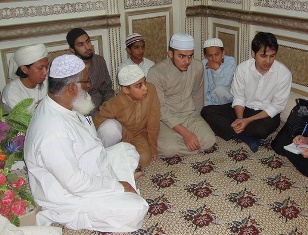
Nov. 21: Pakistani students were enraged after listening to false news that the US had bombed the holiest shrine of Muslims in Mecca. The US Embassy was besieged in Islamabad and set on fire. Al-Mushir (1985) noted that after this news “Christian institutions and even churches were attacked and damaged” in Lahore, Multan and Rawalpindi. “In Rawalpindi a large mob invaded the convent and school of Presentation Sisters and set fire to buildings.”
Catholic Bishop Pereira wrote to the President that “Christians will no longer feel safe and secure. They will feel that international events which have nothing to do with Christians or their institutions will be used as an excuse to harass and harm them.” The military general and President of Pakistan, Zia-ul-Haq, himself visited the school to assure the safety of religious minorities.
1971
Christians in Pakistan were targeted after a book The Turkish Art of Love in Pictures (first published in 1933) was published in Britain. Regarding the book, Husain Haqqani of the Hudson Institute wrote, the Jamaat-e-Islami, a religious party in Pakistan heard about it and denounced its “derogatory references to Prophet Muhammad … During the ensuing riots, Christian churches were attacked, and liquor shops (which were legal at the time) were looted. The British Council building in Lahore was also attacked.”
1965
Hundreds of Pakistan Christians were arrested on charges of espionage during the Indian-Pakistan war of 1965. All of them were later acquitted of the charge, though only after thorough investigation.
The timeline shows that the frequency of such attacks has dramatically increased since 9/11 and how international politics, terrorism and religious extremism now overlap. Though Pakistani Christians are extremely poor and have very little or no representation in higher jobs or political affairs, terrorists appear to target them in a context of international politics, and to capitalize on anti-Muslim sentiment in general. Islamic Studies Chairman at the American University in Washington Akbar Ahmed encapsulates this situation:
“While militant groups are frequently the culprits in attacks on Christians, a general anger against the United States has caused large numbers of people to target Christians, whom they associate with America, as scapegoats.”
